 |
 |
|
 |
Public, private initiative creates center welcoming visitors on Hwy 371 near Brainerd |
 |
 |
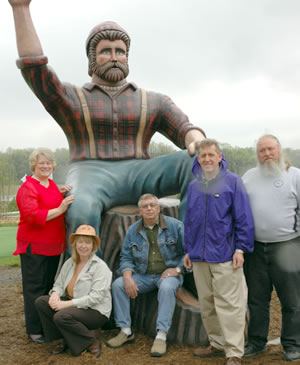 |
|
Posing with the welcome center’s statue of Paul Bunyan are (from left) Lt. Gov. Carol Molnau; Lisa Paxton, BLACC, and the district’s Clancy Wroolie, Gary Niemi and Joe Cameron. Wroolie, building maintenance supervisor, Niemi, area maintenance engineer; and Cameron, chief inspector, provided technical assistance during the center’s planning and construction. Photo by Craig Wilkins |
Travelers heading toward the Brainerd lakes region now have a new resource—the new welcome center on Hwy 371 about five miles south of Brainerd. The new facility offers a rest area, picnic facilities, interpretive displays, a staffed information counter and a gift shop.
The center represents a joint effort by four state agencies, Crow Wing County and the Brainerd Lakes Area Chambers of Commerce.
The center was planned to combine a high degree of functionality with design features such as cedar beams and arches and a fieldstone foundation that reflect the region’s architectural styles and native materials.
Planning for the new facility started about 10 years ago when BLACC leaders and state agency staff envisioned a center that would welcome travelers, vacationers and people who might consider living or investing in the region.
Staff from the chambers and from the departments of Natural Resources, Public Safety, Transportation and Explore Minnesota Tourism found ways to create the center by using a mix of public and private funds.
Their efforts included passage of special legislation. It allows, for example, the BLACC to occupy public right of way, operate a business and collect revenue from concession and gift sales. The legislation also provided negotiation of a long-term lease that allows the BLACC and Mn/DOT to share maintenance and operation of the facility.
Their vision created the center which features vaulted, paneled ceilings, a native stone fireplace and a map of the region that covers the floor of the main visitors’ area. The center also includes a gift shop and an information counter staffed by the chambers of commerce employees.
The Minnesota State Patrol maintains an office in the center to support the operations of its Brainerd District.
The center also includes high-speed, wireless Internet service and a statue of the legendary Paul Bunyan that was unveiled at the center’s dedication.
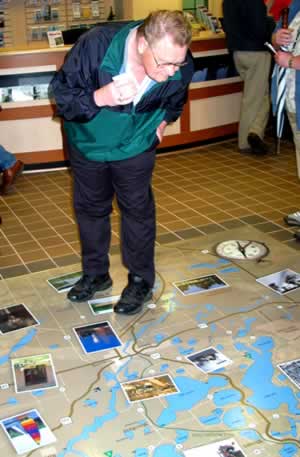 |
Don Raisenen, who retired in 2000 as the District 3 engineer, checks out the map of the Brainerd Lakes area that covers the floor of the new Hwy 371 Welcome Center. The visitors area also includes an information counter and a gift shop. Photo by Jenny Seelen |
Speaking at the dedication, Lisa Paxton, BLACC director, lauded the cooperative effort including support from District 3, the Office of Site Development’s design expertise and the efforts of other state agencies and other project partners.
“This partnership was a real partnership,” she said. “This isn’t just a government building; area businesses donated or provided construction work, building materials, furniture and equipment at a discount that made this kind of visitors’ center affordable.”
Paxton also recognized the contributions made to the program by the late Curt Eastlund, the District 3 project development engineer who died in a traffic crash in 2003.
“Curt was a great champion; it would not have been possible to reach our goals without him,” she said.
Lt. Gov./Commissioner Carol Molnau praised the project’s cooperative efforts.
“This partnership has evolved over time,” she said, “and its members have learned many things along their journey. Today, the project partners look forward to providing additional services to the traveling public without increasing the department’s rest area program costs statewide.”
By Craig Wilkins
|
back

|
 |
Governor vetoes transportation funding bill, calls special session |
 |
 |
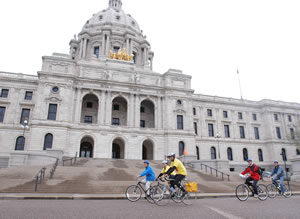 |
|
The 2005 legislative session officially ended at midnight, May 23. The governor called for a special session to begin a few minutes after adjournment so work could start on unfinished business--including a bill that would provide funding for Mn/DOT's operations and transportation projects. Photo by David Gonzalez |
Even before the gavel dropped late Monday night signaling an end to the 2005 legislative session, the governor notified legislators that he was calling them back for a special session one minute after the last chamber adjourned.
Although legislators passed a transportation funding bill, the governor vetoed it May 19 because it contained a 10-cent per gallon gas tax increase. The governor said he would support a gas tax increase only if voters approved such an action on the 2006 general election ballot.
“The bill the governor vetoed had a drafting error that would have reduced expected transportation funding in the next biennium by more than $600 million,” said Bob McFarlin, assistant to the commissioner for transportation policy. “We continue to support Gov. Pawlenty's 10-year, $7 billion transportation investment plan, as proposed in December 2004.”
McFarlin said that “the cornerstone of the governor's investment plan,” the constitutional dedication of 100 percent of Motor Vehicle Sales Tax revenues to transportation, was approved by the Legislature and will go before voters on the 2006 ballot.
Also in limbo is Mn/DOT's biennial operating budget, which was part of the vetoed legislation. This is the state money the department uses for construction, maintenance and salaries.
Besides the gas tax increase, the governor opposed other provisions in the transportation funding bill, including the authority for counties to impose a $20 wheelage tax and an increase in license tab fees.
One important piece of legislation affecting transportation that the governor signed in April was the capital bonding bill, which included nearly $100 million to support transportation, including the Northstar commuter rail, local roads and bridges, and the Cedar Avenue (Hwy 77) bus rapid transit project in the Twin Cities metro area.
By Chris Joyce
|
back

|
 |
Memorial Day weekend kicks off renewed work zone safety campaign |
 |
 |
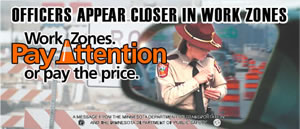 |
|
This image is one of a series being used to promote the work zone safety campaign. |
As the Memorial Day weekend approaches, Mn/DOT renews its work zone safety awareness campaign urging motorists to “Pay Attention or Pay the Price” while driving through highway work zones.
“Our highway workers are highly trained, visible and professional,” said Lt. Gov./Commissioner Carol Molnau. “However, their safety and the effectiveness of the work they do depends heavily on drivers’ paying full attention, observing speed limits and following directions from signs and flaggers.”
The four-month safety campaign will focus on building public awareness of the dangers of unsafe driving in work zones. The campaign will use radio ads, billboards, signs posted on gas pumps and in restaurants and movie theater ads asking drivers to share the responsibility for safe work zones with highway workers throughout the state.
 |
The safety campaign’s slogan, “Work Zones: Pay Attention or Pay the Price,” stresses the need for motorists to watch out for highway workers and their own self-interest. |
The campaign’s slogan, “Work Zones: Pay Attention or Pay the Price,” stresses the need for motorists to watch out for highway workers and their own self-interest. Motorists traveling in work zones suffer by far the greatest from the costs of crashes, injuries and deaths.
The price can also include doubling of the fine for exceeding the posted speed limit.
Molnau said motorists who avoid distractions (such as using cell phones), observe speed limits and allow a safe distance between their vehicles and others will help ensure their safety and others in highway work zones.
|
back

|
 |
MnPASS express lane sees 9,000 trips during first week of operation |
 |
 |
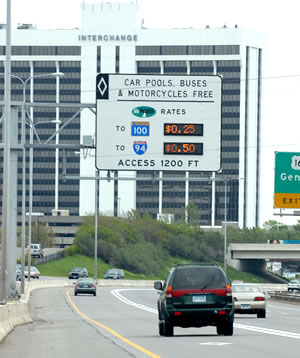 |
|
The MnPASS I-394 Express Lane officially opened for business May 16. More than 9,000 trips were made in the lane during the first week of operation. To date, more than 5,800 transponders have been leased. Photo by David Gonzalez |
Rush hour on Interstate 394 between downtown Minneapolis and the western suburbs started getting better for some May 16, when Lt. Gov./Commissioner Carol Molnau officially opened the new MnPASS I-394 Express Lanes.
"MnPASS ushers in an era of choice and efficiency in the I-394 corridor,” Molnau said. “It is a very smart way to make better use of the capacity in the I-394 high occupancy vehicle lane. And, it will preserve the advantages already enjoyed by the thousands of transit and car pool users who drive this road each day.”
In its first week of operation, the MnPASS I-394 Express Lane has performed as expected, according to project staff.
More than 5,800 transponders have been leased as of today. During its first week, the lane saw more than 9,000 trips along I-394. This includes eastbound and westbound trips that traveled any distance in the Express Lane.
Toll rates varied from 25 cents to $8. About 3,000 trips were at the 25-cent rate, and seven drivers paid $8 to use the Express Lane during the week.
The busiest hours during the week were 7 a.m. to 8 a.m. on the eastbound side, and 5 p.m. to 6 p.m. on the westbound side. The busiest day of the week was Wednesday, May 18, when the lane carried 2,124 trips.
Traffic congestion has increased on the westbound side in the vicinity of Louisiana Avenue in the mornings, due to the closing of the high occupancy vehicle lane to single occupant vehicles without transponders. However, the eastbound side of I-394 has worked well throughout the day.
Mn/DOT is preparing to enter Phase II of the MnPASS project, which involves adding an auxiliary lane on the westbound side of I-394 from Louisiana Avenue to the Hwy 169 exit ramp. The lane should help alleviate the congestion problem in that area. The auxiliary lane should be completed by October 2005.
By Kevin Gutknecht
|
back

|
 |
Budget, data practices, homeland security among issues discussed at managers’ meeting
|
 |
 |
Mn/DOT managers met in St. Cloud today to hear from their peers on critical topics affecting the department such as state and federal budget impacts, data practices responsibilities, homeland security, Drive to Excellence and media relations.
They also heard from Lt. Gov./Commissioner Carol Molnau, who through use of Web technology, was able to broadcast her address simultaneously to employees who tuned in at their desks or in videoconference rooms.
In her comments, Molnau lauded the work Mn/DOT has accomplished during the past 12 months and the work the department is undertaking this year.
“After two and a half years at Mn/DOT,” she said, “I’m learning more and more about what dedicated public servants you all are—always putting Minnesota citizens first whenever you make decisions and (act). That’s the sign of a strong department, a strong agency, but even more, strong public servants.”
Also at the meeting, each division recognized some of the people and work units who have been instrumental in their work. For a list of those acknowledged, click on Friends of the Divisions.
An audio recording of the lieutenant governor’s address and the questions she fielded can be heard by clicking on the following internal links:
|
back

|
 |
Mn/DOT to repair historic bridge over Lester River in Duluth |
 |
 |
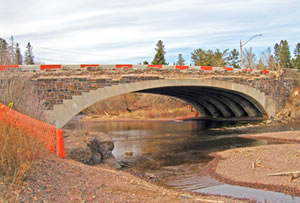 |
|
The 70-year-old London Road (Hwy 61) bridge over the Lester River in Duluth suffered damage when a semi-trailer truck plowed into the structure’s lakeside guardrail. Photo by John Bray |
The London Road (Hwy 61) bridge over the Lester River in Duluth didn’t “fall down” last month, but it was seriously damaged when a semi-trailer truck plowed into the structure’s lakeside guardrail. The crash destroyed about 145 feet of the 160-foot-long, hand-laid, stone masonry wall. It also knocked off part of the bridge fascia.
Mn/DOT District 1 staff determined that the 70-year-old bridge suffered no structural damage.
“We closed the bridge then reopened the roadway about five hours later after placing temporary barriers along the side and closing the sidewalk. It’s not pretty, but it’s safe to cross,” said Gus Peterson, program management specialist with the district.
Peterson said Mn/DOT will work with the state historical society and city of Duluth to determine the best way to repair the bridge.
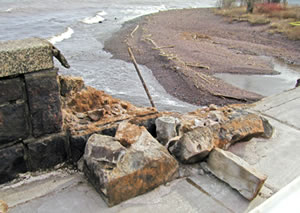 |
Pieces of the damaged bridge lay in the roadway. Some of the salvaged bridge materials will be used in reconstructing the stone wall. Photo by John Bray |
“We have received approval for an emergency order which will allow us to expedite this repair and also to select a contractor who we know is qualified to perform this very specialized work,” said Peterson. “We want to get this restoration started as soon as possible, but need to be cautious that we satisfy the very stringent standards associated with the bridge's historical significance.”
Peterson added that the repair plans have attracted the interest of the Duluth historical community and it will likely monitor Mn/DOT’s activities very carefully.
Since the other railing on the bridge is undamaged and the original bridge plans exist, staff from Mn/DOT’s Cultural Resources Unit and from the Minnesota State Historical Preservation Office have determined that reconstruction is feasible. The new feature will match the old in design, color, texture and, where possible, materials. The salvaged material will be used in the reconstruction.
Cost estimates are being developed and district staff anticipates that the work will be completed this summer. Peterson said Mn/DOT would pay for the repairs then bill the insurance carrier for the firm that owned the truck.
“We expect full reimbursement for all crash-related repair costs,” he said.
By Jeanne Aamodt
|
back

|
 |
|
 |



